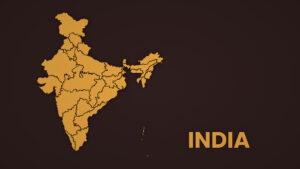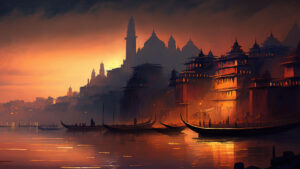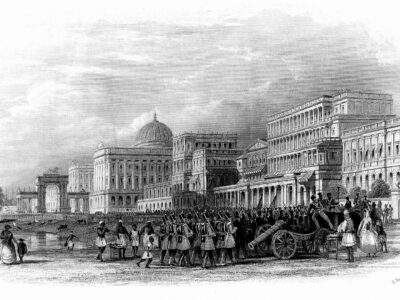Kumbha Mela is said to be the world’s largest religious gathering. This momentous religious festival cyclically takes place once in 12 years, linked to the completion of one revolution of Brihaspati.
Kumbha Mela is usually held at four recognizable holy places:
- Triveni Sangam at Prayagraj is a sacred place where the confluence of three rivers, Ganga, Yamuna and Saraswathi, take place.
- On the banks of the river Ganga at Haridwar
- On the banks of the river Godavari at Nashik
- On the banks of the river Kshipra at Ujjain
The Kumbha Mela is of three types
- Ardha Kumbha Mela occurs once in 6 years
- Poorna Kumbha Mela occurs once in 12 years
- Maha Kumbha Mela occurs once in 144 years
In Hindu mythology, during the Samudra Manthana, that is, the great churning of the ocean as the Goddess Mohini, the disguised form of Lord Vishnu, while carrying away the pot containing the nectar of immortality towards heaven from the grip of demons, it is believed that few drops of amrita fell on the four sacred sites – Prayag, Haridwar, Nashik and Ujjain. The pursuit of Goddess Mohini lasted for 12 divine days, equivalent to 12 human years; therefore, the Kumbha Mela is celebrated every 12 years.
Though the occurrence of Kumbha Mela has been in practice from time immemorial, as per the historical records, this celebration might have existed during the period of the Guptas, and the first description of Kumbha Mela was recorded in the accounts of Hiuen Tsang, a Chinese Buddhist monk. He travelled to India sometime between 629 to 645 CE.
Intensely implanted in Hindu belief is the idea of physical and spiritual sanctification. The Kumbh Melas involve pilgrimage travel to the four places of holy presence and communal bathing in the waters of the sacred rivers. For the pilgrim, bathing is the climax of the journey, the fulfilment of a meditative and healing process for the individual and motivating for the collective in religious terms.
From ancient times, these melas have been associated with the practice of commerce, initiation of spiritual practice, the procession of ascetics and warrior monks, recitation of hymns and prayers, debates and discussions. Holy bathing takes place on six auspicious days, starting from Makara Sankranti, followed by Paush Poornima, Mouni Amavasya, Basant Panchami, Magha Poornima and the last on Maha Shivarathri during each cycle of Kumbha Mela.
Although this Hindu tradition involves a peaceful gathering and celebration, the occasion of Kumbha Melas witnessed several rebellious acts, hard violence and massacres throughout history for various reasons. In the colonial period, the British government established the order for the ascetic groups to perform holy baths and rituals in auspicious periods to avoid conflicts. The participation of pilgrims and ascetics at this event in the past was limited; however, the appearance of the crowd at the festival exploded in numbers by the late 19th century.
THE FESTIVAL
The celebration of Kumbha Mela is the blend of religious culture, spiritual life, faith and festivity that lasts for a month or more. The colourful flags, crowded streets, numerous tents and flashing lights are a feast for the eyes.
The key highlights of Kumbha Mela are:
- The Royal Bath
- The Akharas
- The Connection Between Devotees & Sadhus
- The Sacrifices
THE ROYAL BATH
In Indian tradition, most ancient temples are situated close to the rivers, and a holy dip in such rivers carries high spiritual value. Dipping fully into the waters of river Ganga and performing libation means much more for a Hindu pilgrim, and they believe performing Ganga snaan washes away all sins.
The royal bath during the occasion of Kumbha Mela refers to dipping into the river Ganga on specific days and times considered astrologically auspicious. The belief is that baths at such auspicious times carry amplified cosmic energies and bestows the devotee with fruitful results, equivalent to thousand holy dips on ordinary days. The royal bath is the spiritual pull that attracts millions of pilgrims and ascetics to partake in the Kumbha Mela.
THE AKHARAS
The other unique feature of Kumbha Mela is the Akharas, encampments of ascetics. Akhara is a place that facilitates accommodation and training for those who wish to initiate their spiritual journey by renouncing their worldly desires. Based on different traditions and values, 13 officially registered Akharas exist in India and are further divided into three groups – Nirvani, Digambar and Nirmal.
The chiefs of Akharas are of the highest priority in Kumbha Mela, and they ride on grand processions portraying the emblem of their orders along with their disciples and followers. The yogis perform demonstrations of their spiritual accomplishments. The orders of Akharas are given the privilege and exclusive rights for the royal bath at Triveni Sangam on the auspicious days. Many pilgrims seek blessings from these yogis by visiting their encampments.
THE CONNECTION BETWEEN DEVOTEES & SADHUS
As the Kumbha Mela hovers, many wealthy sponsors nationwide contribute to the Akharas and religious organizations to cover the expenses of encampments, food supplies, accommodation, performance areas and other requisites and ensure the daily arrangements are in place. Other than this, followers, disciples and members associated with gurus and the chiefs of Akharas also join hands to support this cause. Some people support the congregations as a social responsibility and voluntarily participate in operations, while others do the charities to gain religious merits.
The occasion sustains everyone’s faith, strengthens social bonding, and helps promote a harmonious connection between the devotees and sadhus. The devotees also find their gurus to initiate their spiritual journey, receive blessings, gain spiritual knowledge and seek remedies for their problems from the yogis.
THE SACRIFICES
Under the guidance of spiritual gurus, the aspirants who desire to indulge in the spiritual practice sacrifice material comforts, renounce personal bondage with family and communities and endure hardships to proceed with stringent life of devotion to attain salvation.
Kumbha Mela reflects the extreme values of Hindu traditions and is the largest occasion held on such a colossal scale in the entire world.








